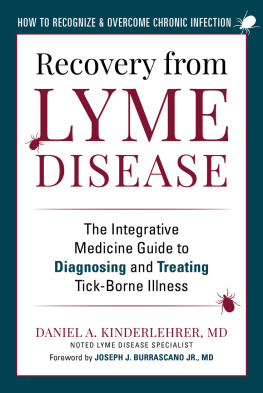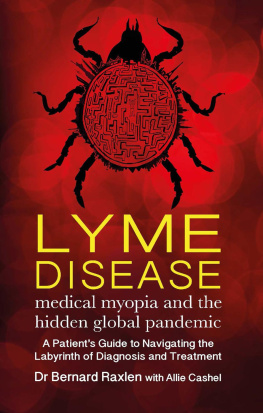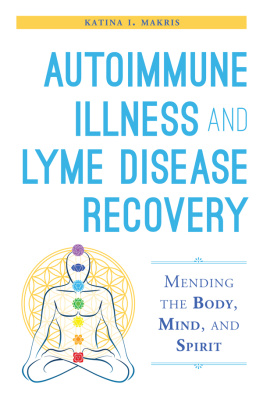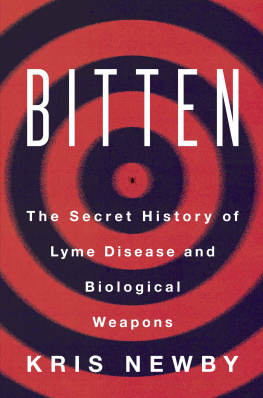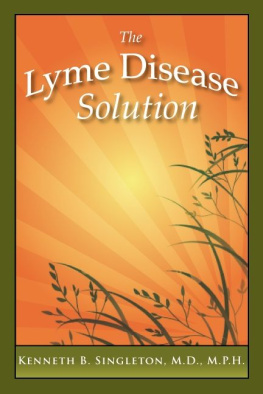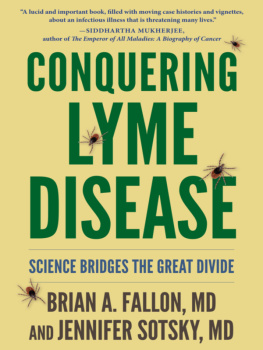Daniel A. Kinderlehrer - Recovery from Lyme Disease: The Integrative Medicine Guide to Diagnosing and Treating Tick-Borne Illness
Here you can read online Daniel A. Kinderlehrer - Recovery from Lyme Disease: The Integrative Medicine Guide to Diagnosing and Treating Tick-Borne Illness full text of the book (entire story) in english for free. Download pdf and epub, get meaning, cover and reviews about this ebook. year: 2021, publisher: Skyhorse, genre: Romance novel. Description of the work, (preface) as well as reviews are available. Best literature library LitArk.com created for fans of good reading and offers a wide selection of genres:
Romance novel
Science fiction
Adventure
Detective
Science
History
Home and family
Prose
Art
Politics
Computer
Non-fiction
Religion
Business
Children
Humor
Choose a favorite category and find really read worthwhile books. Enjoy immersion in the world of imagination, feel the emotions of the characters or learn something new for yourself, make an fascinating discovery.
- Book:Recovery from Lyme Disease: The Integrative Medicine Guide to Diagnosing and Treating Tick-Borne Illness
- Author:
- Publisher:Skyhorse
- Genre:
- Year:2021
- Rating:4 / 5
- Favourites:Add to favourites
- Your mark:
- 80
- 1
- 2
- 3
- 4
- 5
Recovery from Lyme Disease: The Integrative Medicine Guide to Diagnosing and Treating Tick-Borne Illness: summary, description and annotation
We offer to read an annotation, description, summary or preface (depends on what the author of the book "Recovery from Lyme Disease: The Integrative Medicine Guide to Diagnosing and Treating Tick-Borne Illness" wrote himself). If you haven't found the necessary information about the book — write in the comments, we will try to find it.
Daniel A. Kinderlehrer: author's other books
Who wrote Recovery from Lyme Disease: The Integrative Medicine Guide to Diagnosing and Treating Tick-Borne Illness? Find out the surname, the name of the author of the book and a list of all author's works by series.
Recovery from Lyme Disease: The Integrative Medicine Guide to Diagnosing and Treating Tick-Borne Illness — read online for free the complete book (whole text) full work
Below is the text of the book, divided by pages. System saving the place of the last page read, allows you to conveniently read the book "Recovery from Lyme Disease: The Integrative Medicine Guide to Diagnosing and Treating Tick-Borne Illness" online for free, without having to search again every time where you left off. Put a bookmark, and you can go to the page where you finished reading at any time.
Font size:
Interval:
Bookmark:
For Jane Kinderlehrer,
who continues to inspire
my life and my work
And for Kay Lyons,
who saved my life
my deepest gratitude
Contents
Foreword
by Joseph J. Burrascano Jr., MD
D r. Kinderlehrer is not only wise and gifted as a doctor, but he has also experienced Lyme in a most personal way. In addition to having seen thousands of patients with various iterations of tick-borne diseases, he himself had Lyme disease and suffered through the all-too-common path of delayed, inaccurate, and incomplete diagnoses and inadequate and incomplete treatments. When a doctor is also a Lyme patient, he or she immediately becomes better at caring for others with Lyme. The best Lyme doctors are the ones who have experienced it themselves, because there are no medical textbooks or courses in medical school that paint a complete and honest picture of these illnesses or offer useful, accurate advice on treatment. In fact, this is the very problem that has prompted Dr. Kinderlehrer to write this book.
Lyme and the associated tick-borne infections present the doctor and patient alike with one of the most complex group of diseases imaginable. Typically, there are multiple triggers, multiple infections, and multiple imbalances all affecting pretty much the entire bodya real nightmare. All of these issues need to be properly addressed for patients to recover.
Todays world of five-minute office visits does not address complex, multifaceted illnesses. The usual scenario is one problem, one diagnostic test, and one treatment (or no treatment) based on the result of that one test. Unfortunately, far too many Lyme patients go undiagnosed or misdiagnosed, or are offered limited treatments that are doomed to failure. The fact that Lyme is the most prevalent and most rapidly growing vector-borne infectious illness in this and many countries only makes this entire crisis more acute.
In the real world of Lyme, diagnosis is based upon taking a detailed history, review of past records, a careful and thorough physical exam, and not one but a series of direct and indirect tests to look for evidence of infections, and then further tests to help define the scope and extent of the problems. In this book, Dr. Kinderlehrer provides guidelines that will facilitate a deeper understanding of how to evaluate and treat this complex illness. As Dr. Kinderlehrer explains, it is not only important to treat the underlying infections, but also the terrain.
I recall the early days of Lyme. I began treating patients back in the 1980s, a time when we had basically no idea which diagnostic tests were best, which medications were most effective and at what doses, nor how long to treat. And as we finally developed insight into how to approach patients infected with Borrelia burgdorferi, the bacterium that causes Lyme, then a new co-infecting germ would be discoveredBabesia, Bartonella, new Rickettsiasand the process was repeated again and again. At the same time, it became clear that treating the infections was not enough. We had to investigate and remedy the downstream effects of these infections.
A detailed and thoughtful road map is sorely needed. And it is in this context that I am so pleased that we have this book by Dr. Kinderlehrer. I wish Id had a book like this back in the day to guide me! It covers just about everythingthe infections, diagnostic tests, treatments, and yes, the all-important terrain. It gives the reader an in-depth, but easily understandable, guide through the many subtleties of tick-borne illnesses. I am impressed with the knowledge presented and grateful for this information, which has helped so many people recover from chronic illness.
To anyone touched by tick-borne diseases, be they a patient, a caregiver, loved one, or health practitioner, this book is a must-read. It will serve as a continuing reference as it gets read and reread to assimilate all it has to offer. I congratulate Dr. Kinderlehrer and thank him for this most impressive work.
Preface
It is not your responsibility to finish the work of perfecting the world, but you are not free to desist from it either.
Rabbi Tarfon, Pirke Avot, Sayings of our Fathers, 2:21
L yme disease is perhaps the most controversial issue in Western medicine today, but regardless, everyone agrees it is a growing epidemic. Over the past thirteen years the number of reported cases has doubled. However, the more than 400,000 new cases of Lyme disease reported in 2017 is likely far lower than the actual numbers because the criteria the CDC uses for surveillance are extremely narrow.
The CDC states that their criteria for reporting should not be used to make the diagnosis in the doctors office.
Long-term studies have demonstrated that anywhere from 10 percent to 53 percent of patients diagnosed with acute Lyme disease The Infectious Diseases Society of America (IDSA) characterizes these chronically ill people as suffering from post-treatment Lyme disease syndrome (PTLDS). In other words, they are deemed cured from Lyme, and instead are suffering some unknown chronic ailment.
There are also a large number of individuals suffering from chronic infection with the Lyme disease pathogen, Borrelia burgdorferi, a.k.a. Bb, who were never diagnosed with an acute infection at all. Instead, they are typically misdiagnosed as having chronic fatigue syndrome, fibromyalgia, an autoimmune condition, or a neuropsychiatric disorder, particularly anxiety and depression. Children are often labeled with oppositional defiance disorder, attention deficit disorder, learning disabilities, eating disorders, autism spectrum disorders, or even bipolar disease.
We do not know how many people suffer from chronic infection with the Lyme spirochete. I refer to these people as suffering from Lyme disease complex, because there are invariably more issues than simply persistent infection with the Lyme bacteria.
I did not start out specializing in infectious disease. When I finished medical school and residency in Internal Medicine in 1979, I opened a practice called Nutrition and Preventive Medicine. My mother, Jane Kinderlehrer, deserves a lot of the credit for this decision. She had been food editor of Prevention Magazine for twenty-five years, and raised me on wheat germ, dark green lettuce, and no sweets. In the 1950s and 60s, she was considered a health-food nut. (I longed for iceberg lettuce and Wonder Bread.) And later, the values she instilled in me regarding nutrition and prevention were not what I learned as a resident in Internal Medicine. My mother was ahead of her time, and decades later her views are now considered mainstream.
When I started my nutritionally oriented practice, I thought I would see individuals who were interested in treating common maladies like high blood pressure with diet and nutrients instead of relying on drugs. But instead I saw people who had fallen through the cracks. They had consulted with a multitude of physicians but had not experienced relief from their chronic symptoms. Labeled with diagnoses such as migraine headaches, irritable bowel syndrome, chronic fatigue syndrome, and fibromyalgia, they wanted to see someone who thought outside the boxsomeone who could tell them why they felt ill, and to help them heal rather than treat their symptoms.
Back then, there were only a handful of us practicing Holistic Medicine. Over time our designation changed: Alternative Medicine, Complementary and Alternative Medicine, and more recently, Integrative Medicine and Functional Medicine. Regardless of the label, we were able to help a lot of patients who had been suffering for a long time, particularly by dealing with food sensitivities, digestive issues, and nutritional supplementation. Unfortunately, there were many patients that were falling through the cracks there as well. When we became aware of Lyme disease, with its propensity to cause so many symptoms, it seemed we had found the answer. And when we began treating this infection, many patients who had been chronically ill improved dramatically.
Next pageFont size:
Interval:
Bookmark:
Similar books «Recovery from Lyme Disease: The Integrative Medicine Guide to Diagnosing and Treating Tick-Borne Illness»
Look at similar books to Recovery from Lyme Disease: The Integrative Medicine Guide to Diagnosing and Treating Tick-Borne Illness. We have selected literature similar in name and meaning in the hope of providing readers with more options to find new, interesting, not yet read works.
Discussion, reviews of the book Recovery from Lyme Disease: The Integrative Medicine Guide to Diagnosing and Treating Tick-Borne Illness and just readers' own opinions. Leave your comments, write what you think about the work, its meaning or the main characters. Specify what exactly you liked and what you didn't like, and why you think so.

